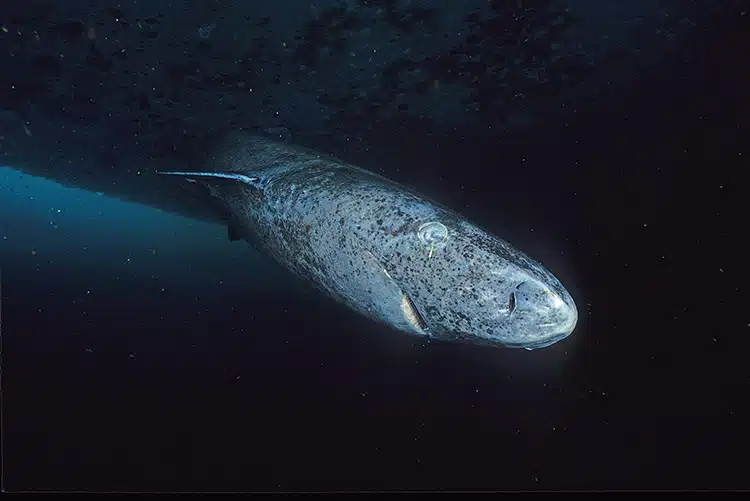
A Greenland shark photographed in 2007 at Admiralty Inlet, Nunavut. (Photo: Hemming1952 via Wikimedia Commons, CC BY-SA 4.0)
Aging is a process all living beings seem to go through, but certainly not in the same ways. Currently, the oldest living person is 117, while the oldest living dog and cat are 24 years and 28, respectively. Some animals, like parrots and tortoises, can clock many decades, with species such as the Galapagos tortoise easily outstripping human lifetimes. But no animal has mastered longevity with the finesse of the Greenland shark (Somniosus microcephalus), also known as the gurry or grey shark. These large, slow-moving Arctic recluses can live up to 500 years. Scientists are still hoping to learn the secrets of this long life to better understand both the species and biological aging processes.
The Greenland shark is a variety of sleeper shark and one of the largest shark species. It stretches an impressive length of up to 23 feet and weighs in at about 1.5 tons. It typically inhabits the chilly, deep waters of the Arctic, although it can migrate to other regions. Despite being a fierce predator, it is quite slow-moving and enjoys a lazy scavenge. The massive beasts are listed as vulnerable. Their incredibly slow gestation period of about eight to eighteen years does not inspire confidence in their rebound ability, nor does the fact that they only reach sexual maturity around age 150.
How does all this reproducing take so long? Well, the extended timeframe is possible due to the record-setting life span of the Greenland shark, the longest-living vertebrate. While scientists continue to investigate just how long this species can persist, testing of one individual’s eyes with radiocarbon technology produced a range of possible birthdates between 1504 and 1744. This shark may have swum at the same time Shakespeare and Queen Elizabeth I lived, and he certainly predated the American Revolution.
Scientists are still working on the answer as to why these sharks have such longevity, but it is possible that metabolism may play a role. Recent work has revealed the sharks’ metabolism does not seem to slow in the same way as aging humans. Enzyme activity preservers, suggesting they may be able to resist the slowing of aging.
“My best guess would be that the deep waters of the Arctic can be a challenging environment to live in, where an animal such as the Greenland shark may not have consistent access to plenty of food, and they may not frequently be in contact with other Greenland sharks,” shared biologist Ewan Camplisson, a doctoral student at the University of Manchester. “Therefore, as a species with low natural mortality rates, their optimal life strategy would be one of a slow growth and building reserves of energy, so that when they do interact with the opposite sex they are in a suitable condition to reproduce.
I believe that if we can work out how the Greenland shark lives so long and how they seem to be so resilient to age-related diseases (such as cardiac disease), we may be able to improve the quality of life within the elderly human population.”
Greenland sharks are an ancient species, living deep within cold ocean waters where they can reach incredible ages of up to 500 years old.
h/t: [Science Alert, Yahoo]
Related Articles:
Clever Dog Learns to “Pay” for Cookies With a Leaf After Watching Students Use Money
Record-Breaking 17 Endangered California Condor Chicks Born at LA Zoo This Year
Monumental Portraits of Tiny Peacock Spiders Flaunting Their Colorful Bodies
9 Fun Facts About Maine Coons, the Gentle Giants of the Cat World
